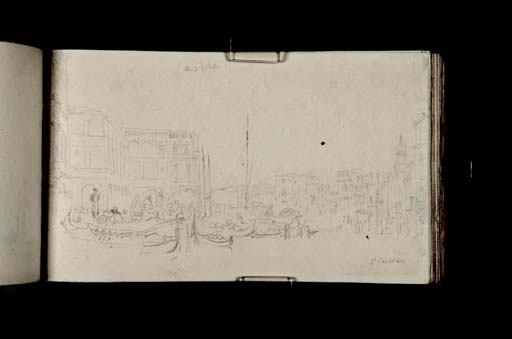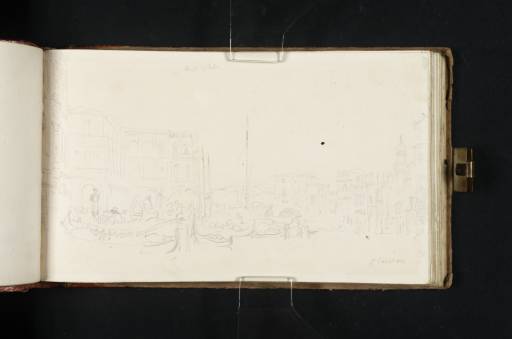Joseph Mallord William Turner The Grand Canal, Venice, with the Fabbriche Vecchie and Nuove beside the Erberia beyond the Palazzo dei Camerlenghi 1819
Image 1 of 2
-
 Joseph Mallord William Turner, The Grand Canal, Venice, with the Fabbriche Vecchie and Nuove beside the Erberia beyond the Palazzo dei Camerlenghi 1819
Joseph Mallord William Turner, The Grand Canal, Venice, with the Fabbriche Vecchie and Nuove beside the Erberia beyond the Palazzo dei Camerlenghi 1819 -
 Joseph Mallord William Turner, The Grand Canal, Venice, with the Fabbriche Vecchie and Nuove beside the Erberia beyond the Palazzo dei Camerlenghi 1819 (Enhanced image)Enhanced image
Joseph Mallord William Turner, The Grand Canal, Venice, with the Fabbriche Vecchie and Nuove beside the Erberia beyond the Palazzo dei Camerlenghi 1819 (Enhanced image)Enhanced image
Joseph Mallord William Turner,
The Grand Canal, Venice, with the Fabbriche Vecchie and Nuove beside the Erberia beyond the Palazzo dei Camerlenghi
1819
Joseph Mallord William Turner 1775–1851
Folio 75 Verso:
The Grand Canal, Venice, with the Fabbriche Vecchie and Nuove beside the Erberia beyond the Palazzo dei Camerlenghi
D14459
Turner Bequest CLXXV 75a
Turner Bequest CLXXV 75a
Pencil on white wove paper, 112 x 185 mm
Inscribed by Turner in pencil ‘Red White’ top centre, and ‘St Cansiano’ bottom right
Inscribed by Turner in pencil ‘Red White’ top centre, and ‘St Cansiano’ bottom right
Accepted by the nation as part of the Turner Bequest 1856
References
1909
A.J. Finberg, A Complete Inventory of the Drawings of the Turner Bequest, London 1909, vol.I, p.515, CLXXV 75a, as ‘“P. Cansiano” (?).’.
1930
A.J. Finberg, In Venice with Turner, London 1930, pp.50, 166, as ‘The Pescaria, from the Erberia, with the Mangilli Valmarana and other palaces in the distance. “P. Cansiano” (query Cassiano)’.
Inverted relative to the sketchbook’s foliation, Turner’s drawing was made on the Grand Canal, at the bend just east of the Rialto Bridge, looking north-west. Finberg subsequently annotated his basic 1909 Inventory entry (‘“P. Cansiano” (?)’): ‘V. on Gd. Canal, looking west from opposite the Pescheria: Valmarana, Micheli dalle Colonne & [?Rech] Palaces on right, with tower of SS. Apostoli’.1 He also noted Turner’s inscription as ‘Prby. Cassiano’.2 The Turner scholar C.F. Bell annotated another copy, suggesting ‘S’ rather than ‘P’ as the preceding letter of Turner’s inscription, and adding: ‘from in front of the Rialto Erberia to r’.3
The Palazzo dei Camerlenghi is included in the foreground at the gutter, framing the arcades of the Fabbriche Vecchie and Fabbriche Nuove fronting the waterside Campo Erberia (vegetable market) beyond, with a prospect along the far side of the canal to the right, where the campanile of Santi Apostoli is shown to the north.4 As Finberg noted, Turner’s inscription below the tower apparently refers to the church of San Canciano (sic), not far east of Santi Apostoli but out of sight here.5
The tall building placed about two thirds of the way across the page, right of the tall mast, is the Palace Michiel dalle Colonne, with the Palazzo Michiel del Brusà just to its right; about half way between them and the edge of the page is the tall Ca’ da Mosto. Lightly indicated at the very edge appears to be a bay of the Palazzo Crivan. Finberg remarked: ‘The dulness [sic] of the Erberia buildings is redeemed by the picturesque group of boats which fill the centre of the design’.6
The drawing on folio 43 verso (D14396) is from about the same viewpoint, but with more of the palazzo shown on the left and the Erberia on the right. For other drawings made in the vicinity and an overview of Turner’s coverage of Venice, see the sketchbook’s Introduction.
Matthew Imms
March 2017
How to cite
Matthew Imms, ‘The Grand Canal, Venice, with the Fabbriche Vecchie and Nuove beside the Erberia beyond the Palazzo dei Camerlenghi by Joseph Mallord William Turner’, catalogue entry, March 2017, in David Blayney Brown (ed.), J.M.W. Turner: Sketchbooks, Drawings and Watercolours, Tate Research Publication, July 2017, https://www

